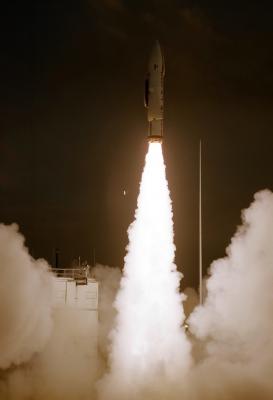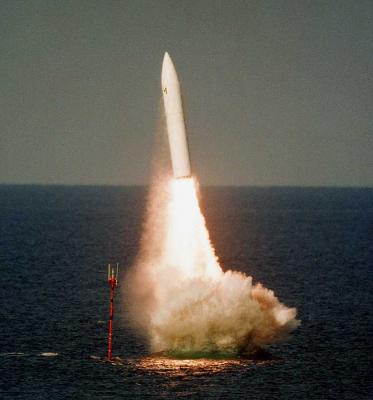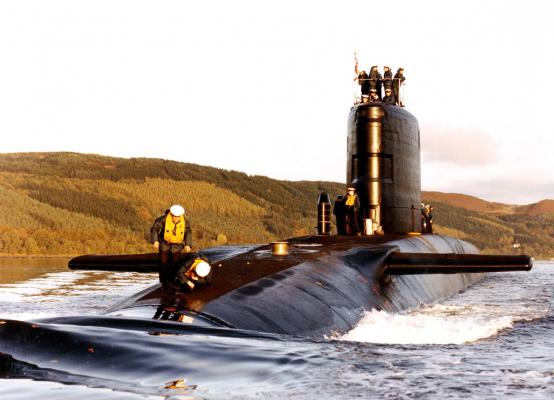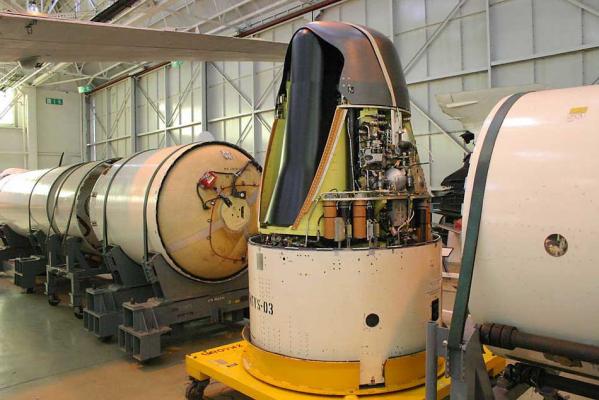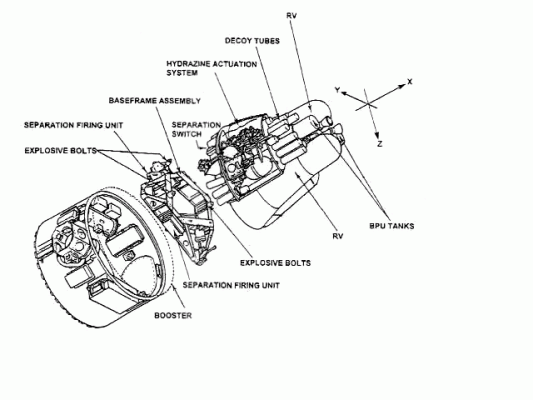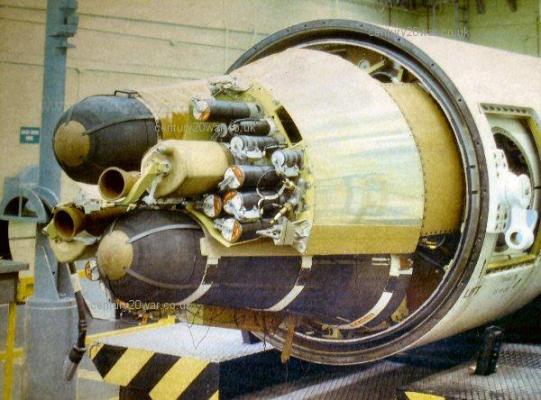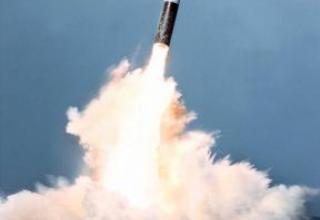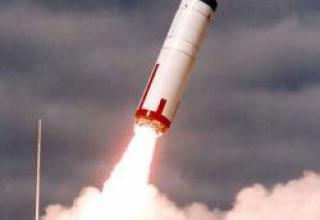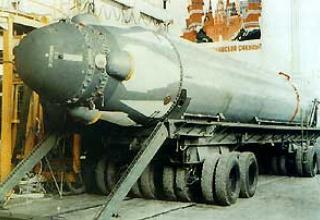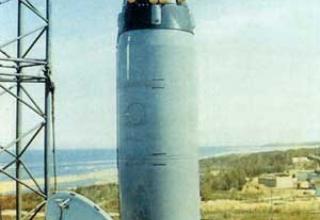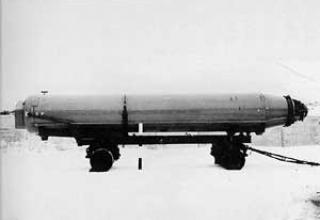The history of the Polaris-A3TK SLBM dates back to 1964, when the British, concerned about the missile defense works carried out in the USSR, launched the HR169 research program to address the problem of a possible reduction in the effectiveness of the promising British naval strategic nuclear forces. In June 1967, the American Polaris-A3T SLBM was chosen to equip the British Navy's promising Resolution SSBNs. A year later, the British Ministry of Defense began to study the data obtained in the course of the American Antelope project. As part of this programme, the Polaris-A3T SLBM was to be equipped with a Missile Defense Override System (ABM system) and an advanced nuclear blast-proof control system (NIRS) by reducing the number of combat units from three to two. Despite a significant improvement in the main characteristics, the flight range of the upgraded model was reduced from 4630 km to 3710 km. Later on, the US abandoned the Antelope program in favor of a more advanced Poseidon-C3 SLBM. The British decided to do otherwise and in 1968-1970 carried out the research program "Super Antelope". The main emphasis in these developments was to further improve the stability of the Polaris-A3T missile, its combat units and parts against PSNF. The missile was to receive an improved SSB missile defense. It was planned to build combat orders by means of a dilution stage equipped with a combined liquid-solid propulsion system and providing for pointing two combat units at individual targets. The new thermonuclear BC was to have increased power. Work on the advanced missile began in 1970 under the KH793 Artificer program.
However, the main ideas of the "Super Antelope" program from the very beginning had strong opposition from the British military, which from 1965 proposed to choose for rearmament of SSBNs promising American missile "Poseidon-C3" and other options:
- "Mini-Poseidon" - equipment of the "Polaris-A3T" SLBM with a breeding stage of the "Poseidon-C3" SLBM with six BB (1971);
- "Hybrid" ("Stag") - a variant of the "Poseidon-C3" SLBM, equipped with a CSP missile defense developed under the "Super Antelope" program (1972);
- "Option M" - a variant of "Poseidon-C3" SLBM with no possibility to point the UAV at individual targets (1973).
All options were consistently rejected by British politicians, and in March 1974 it was announced that the KH793 "Artificer" program was transformed into the "Chevaline" program, the direct design work under which began in January 1975. The main contractors were the Atomic Weapons Research Centre in Aldermaston (AWE), the Royal Aircraft Establishment (RAE) in Farnborough, Hunting Engineering and Sperry Gyroscope. AB, SSB missile defense and a number of critical components were tested at Woomera Missile Range in Australia. Numerous American contractors were involved in the work, the main of which was the Lockheed Aerospace Corporation. By the end of 1979 more than 1 billion pounds sterling had been invested in the program.
Flight tests of the upgraded Polaris-A3TK missile under the Chevaline program began in September 1977. It was launched from the LC29A test rig at the Eastern Rocket Test Range (Patrick Air Base, Florida). Until May 1980, 11 launches were made, all fully or partially successful. In May 1974, an underground nuclear explosion "Fallon" (British designation "Arbor") was conducted at Nevada Test Site (USA), during which a nuclear device "Forrester" was tested, which was a prototype of the primary unit (or trigger) for a new ammunition developed for the missile "Polaris-A3TK". The trigger itself was later named "Harriet". This trigger, compared to a similar purpose-built Jennie node used in the ET.317 ET.317 Polaris-A3T SLBMs that have been in service with British SSBNs since 1968, had significantly increased resistance to nuclear blast threats such as neutron and X-rays, giving the British hope that the new trigger would be able to withstand the close explosion of the Soviet anti-missile and then be suitable for the main task. Such requirements led to the fact that the development of this trigger, compared to the Jennie node, had to design the device completely over again, having considered at least 13 options only by August 1973. As a result, a radically new, radiation-resistant design was chosen. The blast power was about 35 kt, the test was considered successful. The design of the Polaris-A3TK ammo was "frozen" in August 1975 - without an emergency it was forbidden to make any changes in the design documentation and technological processes. However, a year later, in August 1976, an underground thermonuclear explosion "Banon" (British designation "Anvil") was conducted at Nevada Test Site (USA). The purpose of the test was to assess the safety and reliability of the warhead, taking into account its planned service life of 10 to 15 years, which suggests that the individual components of the device and the materials used in its construction were subjected to accelerated aging and simulation of the effects of adverse factors. In addition, it was planned that this test would also answer the question of whether it was possible to achieve savings on fissile materials in the production of a new payload, primarily of plutonium. According to various estimates, the power of the tested device was in the range of 55-80 kt. A number of sources, however, note that the design of the Harriet trigger was based on the U.S. device Kinglet, which in turn was the trigger in the W-58 ammunition for the U.S. Polaris-A3 missile units. Ironically, when designing the ET.317 ammunition for "their" Polaris A-3 missiles, the British refused to borrow the Kinglet, considering it unsafe to store and maintain. The hypothesis of borrowing "Kinglet" satisfactorily explains the relatively small amount of testing required by the British to launch a new ammunition for the missile "Polaris-A3TK" in production. In the period 1979-1982. Between 1979 and 1982, 100 BC ET.317 of the British Polaris-A3T SLBMs were "upgraded" to the TK-100 variant (the primary or nuclear unit (also the trigger) of the thermonuclear unit of the BC ET.317, which was named "Jennie", was replaced by a new one - "Harriet", secondary - or thermonuclear unit - "Reggie" remained unchanged). The resistance of the BC to fossil fuels was increased, safety mechanisms were improved, and the capacity of the TK-100 BC was increased to 225 kt. The "surplus" units of the ET.317 BC, formed due to the reduction of the number of consumed BCs, were used by the British to create the WE.177C tactical thermonuclear free-fall bombs with the power of 190 kt, which were removed from service in 1998. It should be noted that the word "finalized" is not taken in quotation marks by chance - in fact, BC was created anew, and the word "finalized" was used by British politicians, who assured their peaceful voters that work on the creation of new nuclear weapons in the country is not carried out and, therefore, the labor pounds of taxpayers go only in a peaceful direction.
The second phase of the tests was conducted in the waters of the Eastern Missile Testing Range in November 1980, with two successful launches from the "Resolution" class Renown SSBNs (see photo of the first launch). After the modernization of the Renown SSBN was completed in January 1982, the third phase of flight tests began. During the first part of this phase, until June 1985, batch launches of missiles from modified SSBNs were conducted, combined with tests of an advanced control system. A total of 13 launches were made in 1982-1985, of which 3 were unsuccessful and the rest were fully or partially successful. During the launches of the second part of the third stage from July 1986 to May 1987, missiles with new marching stages were tested. These launches were combined with party launches of missiles from modified SSBNs. In 1986-1987 there were 8 launches, of which 1 was unsuccessful and the rest were fully or partially successful. The mentioned new marching stages were actually completely remanufactured (only the remanufactured and newly certified nozzle blocks were reused), having received the general designation A3R, which should underline the difference from the previous stages, having received the general designation A3P. The new stages were technically a complete analogue of the previous ones, except that the thickness of the inner layer of heat protection at the rear of newly manufactured engines was slightly increased. It should be noted that from the decision to resume the production of steps and before the start of production of marketable product passed the period of 6 years with a relatively small number of newly manufactured steps (two steps for 61 missiles), which emphasizes the complexity of the problem - the restoration of solid fuel engines that were not produced at the time of the decision more than 10 years, even if the means and technical capabilities. It is reported that the last of the planned first stage engine bodies was manufactured in the US in February 1987, and the last stage was transferred to the UK more than 5 years later - in May 1992, when the SSBNs equipped with Polaris-A3TK missiles had already started to be decommissioned.
The first "Resolution" class "Renown" SSBNs with the "Polaris-A3TK" SSBN went on combat patrol in mid-1982, the last (fourth) class "Revenge" SSBNs of the same class - in 1988. The British assessed the improved missile pretty highly, as. The volley of one SSBN (16 SLBMs) with all its warheads created an unsolvable task for even the promising A-135 missile defense system of the Moscow region (100 anti-missile missiles) - almost simultaneously 32 relatively low-profile and ABI-resistant boost-phase interceptors as well as 64 heavy and at least 368 light inflatable false targets were deployed in outer space together with 16 dilution stages (the debris of which was also supposed to play the role of heavy decoys) and dipole reflector fields. By dramatically increasing the accuracy and power of each BC, the advanced SLBM acquired the capability to engage not only large area targets, but also "point" small targets with low protection. The missile's boost phase provided the capability to engage two ABIs with different targets spaced up to 70 km apart, which favored the Polaris-A3TK over the Polaris-A3T. However, pointing the KKV at different targets was not generally practiced - both KKVs were usually aimed at the same target with a short time interval to increase the probability of destruction, the so-called "2-on-1 cross targeting". Thus, despite the reduction in the number of ABIs and a significant (up to 3,610 km) reduction in the range of fire, the operational effectiveness of the British Maritime Strategic Nuclear Forces has increased significantly. It should be noted that the British have made attempts to increase the combat efficiency of the Chevaline system. The most famous was an attempt to modify the combat equipment of SLBMs. In April 1978, the Fondutta underground thermonuclear explosion was conducted at the Nevada Test Site (USA), where the Firstrate device was tested as a prototype for a new payload, a light version of the already developed Polaris-A3TK SLBM. It was planned that the charge based on the tested device would eventually increase the missile's range by about 120 km, the new charge was to be mounted on missiles for a third SSBN, which was then planned to go on combat patrol in 1983. A side objective of the tests was also to obtain additional information for the already developed "heavy" warhead, which suggests that the newly tested device was structurally quite close to the "heavy" warhead, but the declassified documents note that the design of the tested "light" warhead compared to the "heavy" warhead still underwent significant changes, which eventually resulted in some reduction of the power for the "light" warhead, which was to be about 150 kt. The test was assessed as successful, with a capacity of about 85-115 kt, but it was noted that this was 10-20% lower than the projected capacity. The reasons for the British failure were clear and as early as November 1978 the Quargel underground nuclear explosion was conducted at Nevada Test Site (USA), during which the Gavel device was tested. This device, although it was mainly a repetition of the principles outlined in the device "Firstrate", continued the line of promising British "light" warheads. It was announced that the device had been specifically tested at a lower power level than the Firstrate, in order to ensure that as much data as possible was collected for the "light" class of charges when triggered in different power ranges. The main novelty of this device was a noticeable reduction of its geometric dimensions in comparison with "Firstrate", which made it possible to use it as an ammunition in the creation of a new high-speed combat unit, which allows due to a smaller EPR and higher speed to overcome the missile defense system more confidently. The Gavel device was supposed to be the first in a series of small "light" devices developed as part of the Quicksilver project. The test was fully successful - with the planned blast power of 52 kt the real power was 47+/- 5 kt, which actually coincided with the power of ammunition W-68 of the American Poseidon C3 SLBM and confirmed the success of the conceived. Already in January 1979, the British Government announced the fact that it refused to develop further "light" warheads as part of the Chevaline project. There were several reasons for this, first of all the fact that active work in this area hampered the process of creating a "heavy" warhead, which had unconditional priority. It was also important that after the re-evaluation it became clear that a possible increase in the range of a missile with a new "light" warhead will not exceed 100 km. At the same time, it was noted that during the development of "light" warheads important data were obtained and, as it later became clear, these data were actively used in the 80s to develop a warhead for the "British" Trident-II D5 missiles.
The Chevaline programme was, in fact, a temporary measure taken before the British Vanguard class SSBNs entered service. The decision to replace the "Polaris-A3TK" with a new American-made "Trident-I" C4 SSBN was made back in July 1980. And already in March 1982 the Americans agreed to rearm the British SYAS with prospective "Trident-II" D5 SLBMs. The first SSBN of "Resolution" class ("Revenge") was withdrawn from the fleet in 1992. Deactivation of submarines was planned at two-year intervals, which was observed at the beginning - the second boat left the fleet in 1994. However, the overall reduction in funding, coupled with a constant rise in the cost of operating "old" submarines and missiles, forced the process to be accelerated - the two remaining SSBNs were deactivated as early as 1996. By that time, two Vanguard-class SSBNs were already in the UK Navy. The last combat patrol of the Resolution-class SSBNs was in spring 1996.
The last launch of the Polaris-A3TK SSBN from the British SSBN was in 1987. Thus, between 1977 and 1987 a total of 34 launches of the Polaris-A3TK SLBM were made as part of flight tests (later combined with party launches) and combat training launches. Completely unsuccessful launches were 4.
Assessing the Chevaline project as a whole, it can be noted that the main task set by engineers and scientists before the start of work was fulfilled - the British, with the support of the Americans, managed to modify the already existing missile system "Polaris-A3T", that it was able to guarantee the performance of the task set by the UK at that time to the SNF of Great Britain - the task of destroying important strategic targets of the Moscow region of the USSR with the maximum possible human losses. This was in line with the "guaranteed retaliation" strategy practised in the United Kingdom until the mid-1980s. However, after the British agreed in the second half of the 1980s to the US strategy of limited nuclear warfare with selective use of nuclear weapons, it became clear that the concept under which the Polaris-A3TK missile was built no longer met the requirements of the time. Prior to the Trident-II D5 SLBMs, the British Navy did not have the means to respond to conflicts outside Europe involving potential nuclear weapons possessors.
Composition:
The Polaris-A3TK ballistic missile inherited the main design features of its prototype, the Polaris-A3T SLBM. The missile was made of two stages with sequential connection of steps, whose bodies were made of fiberglass by winding the fiberglass with epoxy glueing. Within the framework of a special program carried out since 1981, the first marching stage of the Polaris-A3TK SLBM with the RDT A3P developed by Aerojet General was modified - the insert was replaced, new solid fuel was poured instead of the old one, a number of units were replaced, and measures were taken to increase the stability of the stage against PFC. All Polaris-A3TK missiles were modified as part of this programme during 1986-1987. The first stage RDTT march rocket had four rotary nozzles. The nozzles were made of aluminium alloy with special coatings. To control the engine thrust vector on the first stage of the rocket used ring deflectors, mounted on each of the nozzles and articulated with the appropriate hydraulic drives. Tests have shown the high efficiency of this type of steering device and, in particular, the possibility of taking the missile to the trajectory even with a significant vertical deflection at the moment of switching on the first stage engine. The control system made it possible to control the missile through pitch, yaw and roll channels. The engine was powered by an electromechanical device and a powerful fuse, while the tail plugs of the nozzles, which protected the engine from water ingress during the underwater course of the missile, were pushed out by the working gas pressure at the moment of engine activation.
On the second stage rocket engine X-260, developed by the company "Hercules Powder" four fixed nozzles. Control forces were created by injecting freon into the critical part of the nozzles. Stock of CFC was stored in a toroidal tank, which was filled at factory conditions. This system made it possible to control the rocket through pitch and yaw channels. The second stage of the Polaris-A3TK was also modified. The set of measures taken was approximately the same as for the first marching step. The steps were connected by means of an aluminium alloy adapter. For division of marching steps the fire way was used. In a forward part of the adapter the charge which worked at the moment of division was fixed.
The control system equipment is located in the nonseparable instrument compartment which is in a forward part of the case of the second marching step of a rocket. It housed a platform with accelerometers and a block of high-speed gyroscopes, flight control software, a block of auxiliary electrical equipment, BCVM, power supplies, etc. In the course of the Chevaline program, the control system hardware was significantly modified, first of all, to improve the accuracy of firing and to increase the resistance to fossil fuels. Due to the application of the new element base, it was possible to reduce the weight of the system. The results obtained during the extensive R-1 research project on this topic were widely used to improve the stability of the Chevaline BC and BC systems against PFCs.
The most interesting part of the project "Chevaline" became the head part with a breeding stage - simply because the degree of originality (often simply inexplicable) embedded in it technical solutions, as far as we know, this system had no analogues in the world. The breeding stage (see Scheme-1, Scheme-2, Scheme-3, Scheme-4) was made of aluminium alloys with inclusion in especially responsible places of steel details. Most of the surface of the breeding stage outside had a special heat protection coating to reduce the thermal loads from small head cowling RDTT at the time of its removal. The nose part of the stage, which had the main thermodynamic loads at the moment of head cowling removal, was covered with a heat shield made of organic materials, which was fired off a few seconds after the head cowling was removed. Breeding stage had its own electronic control unit "Electronic Control Assembly" (ECA), which provided: the process of initiation of the breeding stage systems and the MS, the issuance of commands to the propulsion system to orientate the stage in space, power supply to all systems of the stage, and so on. The unit included a power supply unit on thermopile (duration of operation up to 9 minutes with the possibility of extension up to 20 minutes), BCVM control system of the breeding stage (which was made on radiation-resistant electronics EEPROM-type) and a set of auxiliary equipment. All systems of the unit were placed in a housing made of titanium alloy and were shielded from PTFE. The breeding stage was equipped with the "Space Reference Unit" (SRU), which consisted of a complex of gyroscopes and accelerometers. The unit provided the BCVM with data on angular deviations of the breeding stage and accelerations.
An important part of the breeding stage was the "Bus Propulsion Unit" (BPU). The unit consisted of a liquid marching engine running on highly boiling self-ignition fuel components (inhibited red smoky nitric acid IRFNA as an oxidizer and hydrazine MAF-1 as a fuel). The average engine draught is 6.3 kN, full impulse is 77.5 kN. Fuel consumption - 2.5 kg/s. BPU provided change of speed of a dilution stage by an amount up to 200m/s with an accuracy of 0,1m/s. The displacement of fuel components from the tanks was due to the excessive pressure of nitrogen injected into the tanks. The engine had a system of two uncontrollable nozzles, which could operate alternately or simultaneously. Working together with two packs of solid fuel gas generators of different power (each generator had a block of four nozzles), this power plant provided the orientation of the stage of dilution in space and provided the construction of combat orders of the BC and CSP anti-missile defense with sufficient accuracy (see Figure 1, Figure 2).
For separation of a step of cultivation from the second marching step two solid-fuel engines by draught on 24кН which have informed steps relative speed about 30м/with were used. Besides ББ, a step of cultivation carried on itself KSP PRO which has taken places in special pipe-shaped containers. The MAC ABM included heavy and light inflatable false targets as well as dipole reflectors in separate containers. The AB surface was covered with a special radio absorbent coating to reduce the AB's visibility for SPRN radars. This coating, known as 3-Dimensional Quartz Phenolic (3DQP), was British know-how. Technical documentation for this coating was later purchased from the British by the American corporations AVCO and General Electric. This coating was a quartz-containing woven seamless fabric impregnated with a special solution based on phenol-aldehyde polymer and then hot pressed. The covering received thus very well was exposed to machining, being thus dense and incombustible. The coating also provided good protection against PBV, especially against neutron radiation. The Polaris A-3TK MKBMs themselves, developed and manufactured by AVCO Corporation, were a modification of the Polaris A-3T Mk2 MK2 MKBM - the improvements primarily affected the increased resistance of the new MKBMs to PFCs.
According to a number of data, after the completion of combat orders formation from the ballistic missiles and anti-missile defense missiles, the dilution stage was undermined to form an additional mass of chaotically rotating heavy decoys. The original concept of the British Breeding Stage was that the Breeding Stage carried only one ABI directly on it. The second was fixed to the special adapter established on the second march stage, and separated from the second stage practically simultaneously with a step of cultivation by means of the solid fuel engine. Thus, pointing AB was realized by a principle of so-called "partially individual pointing". The weight of the filled up dilution stage without PSP PRO and BB is 318 kg, weight of the fully equipped dilution stage with BB, PSP PRO, heat shield is 735 kg.
The missile compartment and the Resolution-class SSBNs' missile firing control system were fully borrowed from the U.S. Lafayette-class SSBNs. The missile compartment contains 16 Mk7 launchers. Each of them consists of a shaft, a hydraulically driven lid, a seal lid, a steel launch cup, a membrane and equipment for feeding low-temperature steam-gas mixture produced by an individual gas generator for each PU. To access the rocket systems, five hatches are equipped on the launch unit body.
Mk122 missile launch subsystem provides launch of missiles. The missile is ejected from the launch cup by using the pressure of a low-temperature steam-gas mixture. The system ensures the discharge of SLBMs from a depth of no more than 40 m to a height of about 10 m above the water surface. All 16 missiles could be launched in 16 minutes. Launch only underwater.
Characteristics:
| The length of the rocket, m | 9,86 |
| The diameter of the rocket, m | 1.37 |
| The weight of a packed SLBM, t. | 16,6 |
| Mass of combat equipment (stage of dilution, SLC ABM, 2 BB), t | 0,988 |
| Flight range, km | 3610 |
| Circular probable deviation, m. | 450 |
| Number of BB, pcs. | 2 |
| BB power, kt. | 225 |
| 1-stage engine traction at sea level, kN | 356 |
| Apogee height of PPP trajectory, km | 1000 |
Sources:
- The real meaning of the words: a pedantic glossary of British nuclear weapons by www.mcis.soton.ac.uk & R. Moore. UK, 2004.
- Strategic Defence Review / by Secretary of State for Defence G. Robertson presented to Parliament. London, UK, 1998.
- The Future of Britain’s WMD / by D.Plesch. The Foreign Policy Centre, London, UK, 2006.
- Ядерная политика и ядерное вооружение Великобритании / М. Сосновский, «Национальная оборона», №2, 2006.
- А.А. Шумилин «Авиационно-космические системы США». Москва, «Вече», 2005.
- www.lockheedmartin.com
- www.baesystems.com
- www.skomer.u-net.com
- www.astronautix.com
- www.nuclearweaponarchive.org
- www.globalsecurity.org
- www.fas.org
- www.arms.ru
- www.militaryparitet.com
- sci.military.naval
- www.dodmedia.osd.mil
- en.wikipedia.org (B. Burnell pictures, 2006)

